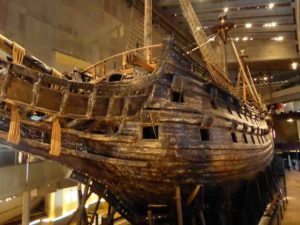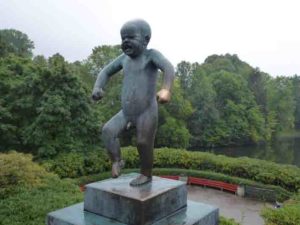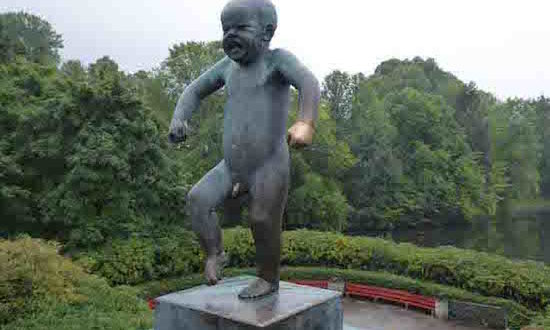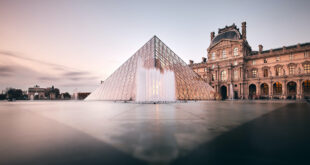Our old Swedish friend Stig, who now lives in New Zealand, had kindly prepared a long list of his favourite places for us to see while in Stockholm, Sweden’s capital City. So we were well prepared to make the most of our short stay there.
We trundled our suitcases from the railway station to our hotel in the late afternoon watching our step so as not to encroach on the cycle lanes. The cyclists are obviously the kings of the road and very speedy!
Our hotel Tegnerlunden was basic but friendly and overlooked a park. Just up the road was a great traditional bakery whose cinnamon buns are legendary and begged to be sampled.
The next morning we started out on Stig’s Big Day Out with a walk downtown, admiring the tall cinnamon and saffron coloured buildings on the way. We needed to pick up our $15 24 hour Seniors Day passes for bus, train and ferry) from the local Tourist Centre. These were great value and a much cheaper option than going on a conducted tour.
 At the top of Stig’s list was the Vasa Museum where the Vasa, a monumental 17th Century war ship is housed, It was the largest ship ever built by the Swedish navy, and is decorated with many elaborate carvings.
At the top of Stig’s list was the Vasa Museum where the Vasa, a monumental 17th Century war ship is housed, It was the largest ship ever built by the Swedish navy, and is decorated with many elaborate carvings.
In 1628 the Vasa set sail in Stockholm Harbour on her maiden voyage. Imagine the looks of horror on the faces of the onlookers when, after 20 minutes, it mysteriously keeled over and sank. Thirty sailors’ lives were lost that day.
The ship remained buried in mud for over 300 years until it was successfully salvaged in 1961, a mammoth effort!
I had thought beforehand that this visit would be more interesting for the blokes but all of us found it fascinating.
As well as viewing the well preserved ship we enjoyed the accompanying exhibitions about the process of its restoration and what life would have been like on board.
Another highlight of our day was the iconic and exceedingly classy Swedish design gallery and shop Svenskt Tenn. Its brightly coloured and patterned textiles and modernist furniture by Joseph Frank, one of Sweden’s most famous designers, are just beautiful (and incredibly expensive!)
Afterwards we caught a public ferry to the island on which Gamla Stan, the old quarter sits with its cobble-stoned narrow winding streets. While the buildings are charming it was very touristy and crowded with many restaurants, bars and shops.
After a good look around it was a relief to sit down for a Fika (a coffee and a bite to eat). This popular Swedish tradition began in the 18th century. The Swedes are greater coffee drinkers than kiwis and average 4 1/2 cups per day!
 Feeling revived we walked further to view the Impressive 18th Century Baroque style Royal Palace, the official residence of the King of Sweden.
Feeling revived we walked further to view the Impressive 18th Century Baroque style Royal Palace, the official residence of the King of Sweden.
We were tempted to call it a day and return to our hotel for nanna and poppa naps but the day was yet young so we hopped on a bus again and went out of the town to see the surrounding suburbs.
Our destination was Stockholm’s lofty communication tower which sits on 72 pillars and is the hub of all radio transmission in Sweden. Those who climb it are rewarded with a spectacular view of the city. After a browse in the excellent souvenir shop on ground level we boarded the bus back to the hotel.
Back at the hotel it was time for a glass or two of wine (We had had the foresight to bring some bottles with us from Vilnius as alcohol is very expensive in Sweden).
Eating out in Stockholm can also be very pricy but that evening we managed to find a reasonably cheap and cheerful pasta and pizza parlour.
Regretfully we never quite made it to some of the other attractions on Stig’s list like the Abba museum and Millesgården, the art museum and sculpture garden, located on the island of Lidingö. But there is only so much you can do when you have so little time.
Oslo
From Stockholm we travelled by train to Oslo, the Capital of Norway.
Norway is an expensive place, particularly for food. Most foods average 2 – 3 times NZ prices. On our first night we went for a ‘cheap’ pizza meal and discovered that a large meaty pizza cost a mind boggling $NZ60! We made do with a smaller pizza between us.
What was amazingly cheap however was the 24 hour travel card in Oslo, which for us oldies was just $7! This entitled us to free access to the metro, buses, trams and ferries and we made very good use of it.
We started our sightseeing by going to the Vigleland sculpture park, with over 200 mostly bronze life size sculptures in a 600 acre park.
This is a really unique Park, a wonderful memorial to the life’s work of the Norwegian sculptor Gustav Vigeland. He not only created the more than 200 bronze, granite and wrought iron sculptures but also designed the whole layout of the park.
While we were able to get close up to almost all of the works its most famous sculpture of a crying baby called Angry Boy was obscured by a group of tourists blocking our view for quite some time while they took endless selfies.
Afterwards we headed back to the waterfront and went for a walk around the old fortress before getting a one hour ferry ride around four nearby islands.
After a quick lunch we went to the Munch museum. While John and brother in law Neil preferred to go for a wander in the adjoining botanical gardens my sister Margreet and I went inside. We were disappointed to find that his most famous painting The Scream as well as many of his other best known paintings were not there but in Oslo’s National Museum of Architecture and Design.There was however a large exhibition showing how the American Expressionist artist Jasper Johns and Munch had found inspiration in each other’s artworks.
Then it was a 30 minute metro ride to the Holmenkallen ski jump high in the hills above Oslo. It looks even scarier with no snow around. This was the ski jumping site in the 1994 Olympics.
After an oldies rest(in our tiny but expensive hotel rooms)we set off again for a really lovely fish meal in a great food hall, a short tram ride away, before a two hour wander along the Akerselva River which was a magical experience.
The autumn equinox was being marked there that night. All electric lights were turned off, and the riverside path was marked by oil candles every 7 or 8 metres. There were lots of kids and older people dressed up, static displays and musical events on the way.
Then finally the number 54 bus took us right back to our hotel, just a couple of minutes’ walk from the central station.
We had had a very full and very enjoyable day. Travelling around the city had been really easy and efficient.
Oslo does give the lie to the oft used argument that Auckland’s population is too small for a good public transport system.
It has a population half that of Auckland, but has 4 metro lines, an extensive bus and tram system, 5 ferry systems going to islands in the harbour plus local rail!
Stockholm and Oslo were two of five Scandinavian Capitals we visited recently. Scandinavia is more expensive than many other parts of the world we have been to. But by being careful to search out the best deals for transport, accommodation and food we managed to keep our costs at a reasonable level..
They are both very attractive and well organised cities and we felt safe and welcome.
By, Lyn Potter










Join the Discussion
Type out your comment here:
You must be logged in to post a comment.